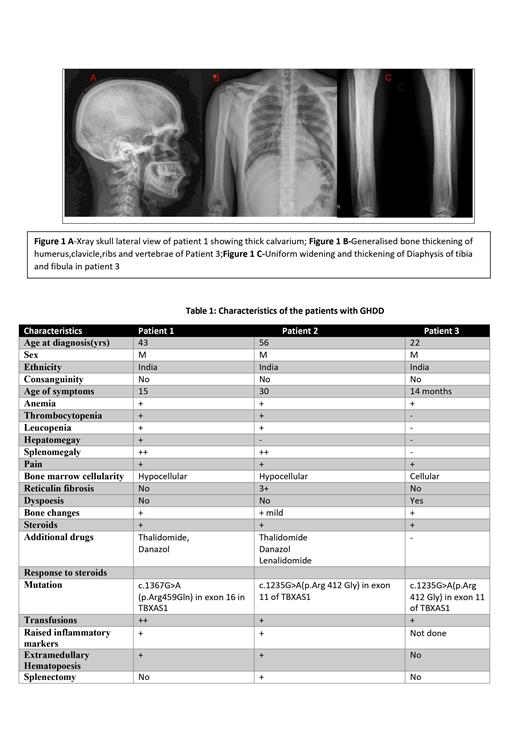Ghosal Hematodiaphyseal Dysplasia (GHDD) is a rare autosomal recessive disorder characterized by bone modeling failure, resulting in thickening of bone cortices with predominant diaphyseal involvement and responsive anemia to steroids. Late diagnosis of GHDD in adulthood can lead to significant morbidity and suboptimal response to steroids. Moreover, GHDD often mimics more common hematological disorders like myelodysplastic syndrome and myelofibrosis, leading to treatments such as transfusions, splenectomy, and hematopoietic stem cell transplantation. Early diagnosis is critical to enable the patient to receive the appropriate treatment.
We present a case series of three Indian patients from different families with genetically proven GHDD. Despite experiencing symptoms from early childhood, all patients were diagnosed in adulthood. None of them were born out of a consanguineous marriage . Two of them, aged 43 and 56, are the oldest reported GHDD patients to date. They initiated steroid treatment in their 5th and 6th decades of life, respectively. Unlike previously reported cases, these two patients required additional drugs like Thalidomide along with steroids, and their response to treatment was not as rapid.
The first patient, a 43-year-old male, had a history of anemia since childhood and became transfusion dependent after 15 years of age. He developed bicytopenia and later pancytopenia with hypocellular bone marrow , along with splenohepatomegaly and extramedullary hematopoiesis in the paravertebral and presacral areas, a novel finding in GHDD cases. Whole exome sequencing revealed a missense mutation in the TBXA2 gene.
The second patient, a 56-year-old male, had a history of anemia since childhood and underwent splenectomy at 46 due to massive splenomegaly and transfusion dependency. However, his transfusion dependency persisted, and bone marrow biopsy suggested myelofibrosis. However he was negativefor myeloid mutations including JAK2. Subsequently, genetic testing revealed a homozygous missense mutation in the TBXAS1 gene. He also developed paraplegia and bladder incontinence, attributed to extramedullary hematopoiesis, which improved with steroid treatment
The third patient a 23 year old man with history of anemia, lower limb tenderness and ecchymosis at 14 months of age. Evaluation then had shown hyperostosis of diaphysis of long bones of lower limbs with sparing of metaphysis and bicytopenia. Was on regular transfusions till 9 years. Re-evaluation with bone marrow studies at 9 years revealed a varying cellular marrow with dysplastic megakaryocytes and diagnosed as pediatric myelodysplatic syndrome ,He was on steroids till 13 years and he did not require further transfusions.He stopped steroids for 1 year following which there was a fall in Hb levels and recurrence of pain in both lower limbs with inability to squat. In view of history of steroid responsive anemia and thickening of diaphysis in X-rays GHDD was suspected and confirmed by genetic testing. He was restarted on steroids and there was a good response to steroids within 4 week with normalisation of hemoglobin levels .
Late diagnosis of GHDD in adulthood can lead to severe complications and suboptimal treatment response. These cases highlight the importance of early diagnosis to prevent unnecessary interventions and improve patient outcomes. Unusual presentations, like extramedullary hematopoiesis, can further complicate the diagnostic process. Clinicians should maintain a high index of suspicion for GHDD in cases of refractory anemia or myelofibrosis-like features, especially in adults with an earlier history of anemia. Early recognition and appropriate management are crucial to mitigate morbidity and improve patients' quality of life
Disclosures
No relevant conflicts of interest to declare.


This feature is available to Subscribers Only
Sign In or Create an Account Close Modal